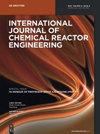Investigation into a multiple input/output bifurcated biochemical reaction with substrate inhibition in a real CSTR based on Cholette’s model
IF 1.6
4区 工程技术
Q3 Chemical Engineering
International Journal of Chemical Reactor Engineering
Pub Date : 2023-03-28
DOI:10.1515/ijcre-2022-0176
引用次数: 0
Abstract
Abstract CSTR operations entailing high nonlinearity and complexity such as multiple input and output steady-states present a real challenge to chemical engineers and process designers. The input multiplicity in chemical reactions leads to control probems such as process instability and low efficiency. Therefore, it is of critical importance to predict and avoid the multiplicity regions during reactor operation. Since the bifurcation analysis of biochemical processes with nonideal mixing has been carried out by the authors in the previous publication (Yang, C. Y., D. C. Tsai, and Y. S. Chien. 2021. “The Strategy Developed for High Conversion and the Multiplicity Problems of Biochemical Reaction in a Real CSTR with Cholette’s Model.” International Journal of Chemical Reactor Engineering 19: 1245–70), the goal of the present work is to use Sturm’s method, Routh stability criteria and the discriminator roots method with the tangent analysis method to derive the input multiplicity conditions in substrate inhibition in a real CSTR based on Chollete’s model. Four kinetic schemes are used in the analysis as examples to show that all three methods can precisely obtain the bifurcation starting point for the input multiplicity. In addition to the multiple input steady-states, the start-up diagram obtained by the discriminator root method is of critical importance to avoid operating in the input multiplicity regions.基于Cholette模型的CSTR中底物抑制的多输入/输出分叉生化反应研究
摘要CSTR操作具有高度的非线性和复杂性,如多个输入和输出稳态,这对化学工程师和工艺设计师来说是一个真正的挑战。化学反应中输入的多样性导致了过程不稳定和效率低下等控制问题。因此,在反应堆运行过程中预测和避免多重区域至关重要。由于作者在之前的出版物中已经对非理想混合的生物化学过程进行了分叉分析(Yang,C.Y.,D.C.Tsai,and Y.S.Chien.2021)。“用Cholette模型为真实CSTR中的高转化率和生化反应的多重性问题开发的策略。”《国际化学反应器工程杂志》19:1245–70),本工作的目标是使用Sturm的方法,Routh稳定性准则和鉴别器根法与切线分析法,基于Chollete模型推导了真实CSTR中底物抑制的输入多重性条件。分析中使用了四种动力学方案作为例子,表明这三种方法都可以精确地获得输入多重性的分叉起点。除了多个输入稳态之外,通过鉴别器根方法获得的启动图对于避免在输入多重性区域中操作至关重要。
本文章由计算机程序翻译,如有差异,请以英文原文为准。
求助全文
约1分钟内获得全文
求助全文
来源期刊
CiteScore
2.80
自引率
12.50%
发文量
107
审稿时长
3 months
期刊介绍:
The International Journal of Chemical Reactor Engineering covers the broad fields of theoretical and applied reactor engineering. The IJCRE covers topics drawn from the substantial areas of overlap between catalysis, reaction and reactor engineering. The journal is presently edited by Hugo de Lasa and Charles Xu, counting with an impressive list of Editorial Board leading specialists in chemical reactor engineering. Authors include notable international professors and R&D industry leaders.

 求助内容:
求助内容: 应助结果提醒方式:
应助结果提醒方式:


